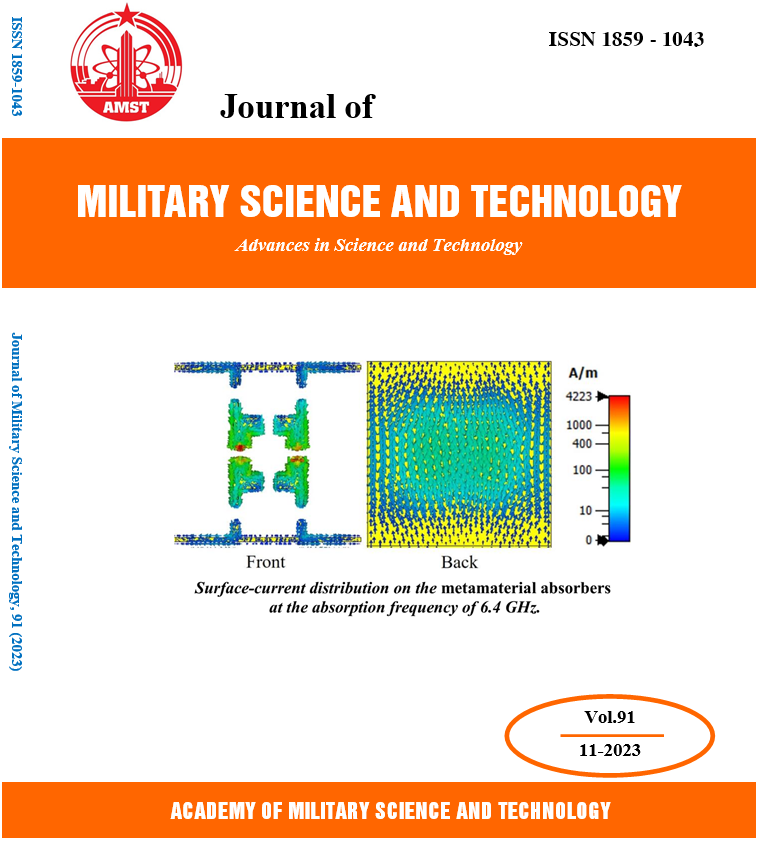Development of data power control algorithms for downlink transmission in cooperative Wireless Body Area Networks
443 viewsDOI:
https://doi.org/10.54939/1859-1043.j.mst.91.2023.11-19Keywords:
Wireless Body Area Networks; Downlink data transmission; Data power control; Channel estimation.Abstract
Wireless Body Area Networks (WBANs) are gaining significant attention for their versatile applications in various fields, including military, healthcare, emergency response, sports, and entertainment. Particularly in remote health monitoring and care, WBANs show great promise. In this article, the authors introduce the "Cooperative WBANs" model, wherein sensors communicate directly with Access Points (APs) without a coordinator. They also present a power control algorithm for downlink data transmission from APs to sensors. Simulation results demonstrate that controlling data transmission power significantly enhances sensor throughput, leading to improved system quality.
References
[1]. H. Tataria, M. Shafi, A. F. Molisch, M. Dohler, H. Sjoland, and F. Tufvesson, “6g wireless systems: Vision, requirements, challenges, insights, and opportunities,” Proceedings of the IEEE, vol. 109, no. 7, pp. 1166–1199, (2021). DOI: https://doi.org/10.1109/JPROC.2021.3061701
[2]. G. Interdonato, “Cell-free massive mimo: Scalability, signal processingand power control,” Linkoping University Electronic Press, vol. 2090, (2020). DOI: https://doi.org/10.3384/diss.diva-167218
[3]. U. Hariharan, K. Rajkumar, and A. Ponmalar, “WBAN for e-healthcare application: Systematic review, challenges, and counter measures,” in 2021 International Conference on Computer Communication and Informatics (ICCCI). IEEE, (2021). DOI: https://doi.org/10.1109/ICCCI50826.2021.9402276
[4]. I. Pandey, H. S. Dutta, and J. S. Banerjee, “WBAN: A smart approach to next generation e-healthcare system,” in 2019 3rd International Conference on Computing Methodologies and Communication (ICCMC). IEEE, (2019). DOI: https://doi.org/10.1109/ICCMC.2019.8819713
[5]. D. S. Bhatti, S. Saleem, A. Imran, Z. Iqbal, A. Alzahrani, H. Kim, and K.-I. Kim, “A survey on wireless wearable body area networks: A perspective of technology and economy,” Sensors, vol. 22, no. 20, p. 7722, (2022). DOI: https://doi.org/10.3390/s22207722
[6]. B. T. Anh, D. T. Quan, and P. T. Hiep, “Developing the max-min power control algorithm for distributed wireless body area networks,” AEU - International Journal of Electronics and Communications, p. 154448, vol 158, (2023).
[7]. P. T. Hiep and R. Kohno, “Control superframe for high throughput of cluster-based WBAN with CSMA/CA,” in 2014 IEEE 25th Annual International Symposium on Personal, Indoor, and Mobile Radio Communication (PIMRC). IEEE, (2014). DOI: https://doi.org/10.1109/PIMRC.2014.7136336
[8]. M. Ali, H. Moungla, M. Younis, and A. Mehaoua, “Distributed scheme for interference mitigation of WBANs using predictable channel hopping,” in 2016 IEEE 18th International Conference on e-Health Networking, Applications and Services (Healthcom). IEEE, (2016). DOI: https://doi.org/10.1109/HealthCom.2016.7749506
[9]. B. Alte and A. Vidhate, “MAC protocol selection and performance analysis in wireless body area networks,” in 2022 IEEE 2nd Mysore Sub Section International Conference (MysuruCon). IEEE, (2022). DOI: https://doi.org/10.1109/MysuruCon55714.2022.9972349
[10]. P. T. Hiep, N. N. Thang, G. Sun, and N. H. Hoang, “Proposal of a hierarchical topology and spatial reuse superframe for enhancing throughput of a cluster-based WBAN,” ETRI Journal, vol. 41, no. 5, pp. 648–657, (2019). DOI: https://doi.org/10.4218/etrij.2018-0571
[11]. Y. Yang, D. Smith, J. Rajasegaran, and S. Seneviratne, “Power control for body area networks: Accurate channel prediction by lightweight deep learning,” IEEE Internet of Things Journal, vol. 8, no. 5, pp. 3567–3575, (2021). DOI: https://doi.org/10.1109/JIOT.2020.3024820
[12]. Z. Zhang, J. Huang, H. Wang, and H. Fang, “Power control and localization of wireless body area networks using semidefinite programming,” in 2015 2nd International Symposium on Future Information and Communication Technologies for Ubiquitous HealthCare (UbiHealthTech). IEEE, (2015). DOI: https://doi.org/10.1109/Ubi-HealthTech.2015.7203357
[13]. T. Wang and Y. Lu, “Advances, challenges and future trends of cell-free transcription- translation biosensors,” Biosensors, vol. 12, no. 5, p. 318, (2022). DOI: https://doi.org/10.3390/bios12050318
[14]. J. K. Jung, K. K. Alam, M. S. Verosloff, D. A. Capdevila, M. Desmau, P. R. Clauer, J. W. Lee, P. Q. Nguyen, P. A. Pasten, S. J. Matiasek, J.-F. Gaillard, D. P. Giedroc, J. J. Collins, and J. B. Lucks, “Cellfree biosensors for rapid detection of water contaminants,” Nature Biotechnology, vol. 38, no. 12, pp. 1451–1459, (2020). DOI: https://doi.org/10.1038/s41587-020-0571-7
[15]. A. M. Q. K. Al-Asadi, K. S. Muttair, A. G. Wadday, and M. F. Mosleh, “Wireless body-area network monitoring with ZigBee, 5g and 5g with MIMO for outdoor environments,” Bulletin of Electrical Engineering and Informatics, vol. 11, no. 2, pp. 893–900, (2022). DOI: https://doi.org/10.11591/eei.v11i2.3219
[16]. V. K. Jhunjhunwala, T. Ali, P. Kumar, P. Kumar, P. Kumar, S. Shrivastava, and A. A. Bhagwat, “Flexible UWB and MIMO antennas for wireless body area network: A review,” Sensors, vol. 22, no. 23, p. 9549, (2022). DOI: https://doi.org/10.3390/s22239549
[17]. Bui Tien Anh, Do Thanh Quan, Pham Thanh Hiep, “Developing the max-min power control algorithm for distributed wireless body area networks”, AEU - International Journal of Electronics and Communications, vol. 158, pp. 154448, (2023). DOI: https://doi.org/10.1016/j.aeue.2022.154448
[18]. H. Q. Ngo, A. Ashikhmin, H. Yang, E. G. Larsson, and T. L. Marzetta, “Cell-free massive MIMO versus small cells,” IEEE Transactions on Wireless Communications, vol. 16, no. 3, pp. 1834–1850, (2017). DOI: https://doi.org/10.1109/TWC.2017.2655515
[19]. M. B. Majed, T. A. Rahman, O. A. Aziz, M. N. Hindia, and E. Hanafi, “Channel characterization and path loss modeling in indoor environment at 4.5, 28, and 38 GHz for 5g cellular networks,” International Journal of Antennas and Propagation, vol. 2018, pp. 1–14, (2018). DOI: https://doi.org/10.1155/2018/9142367







